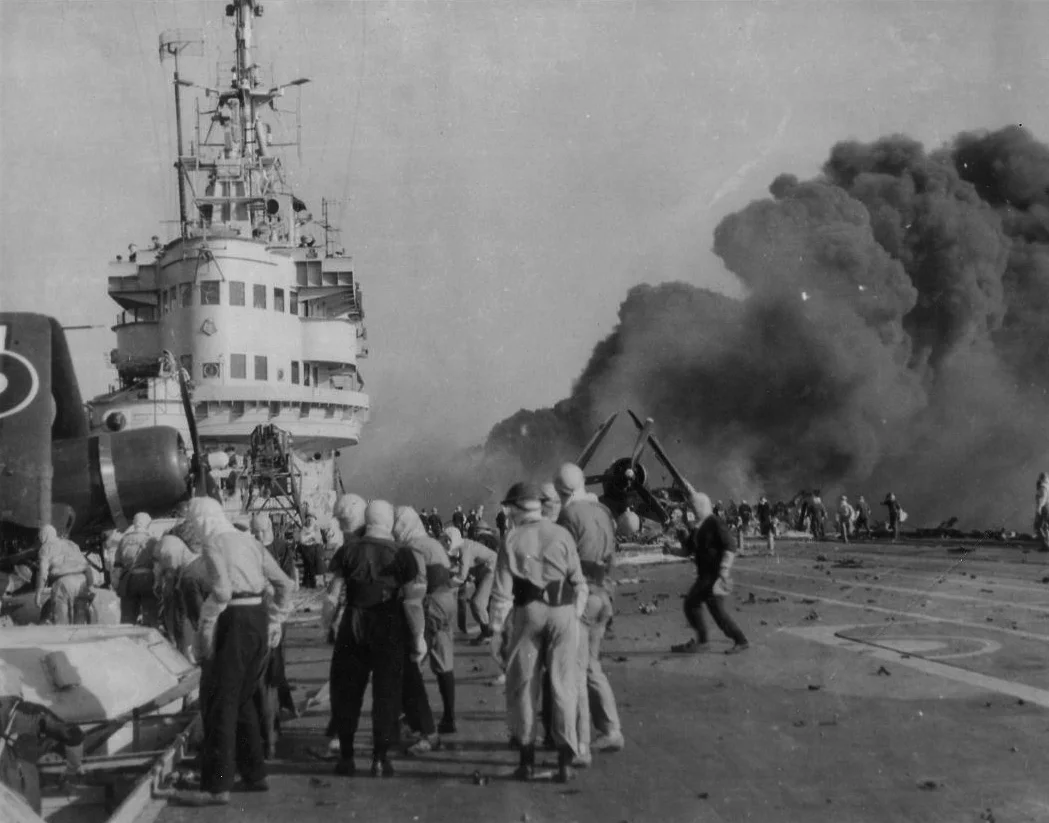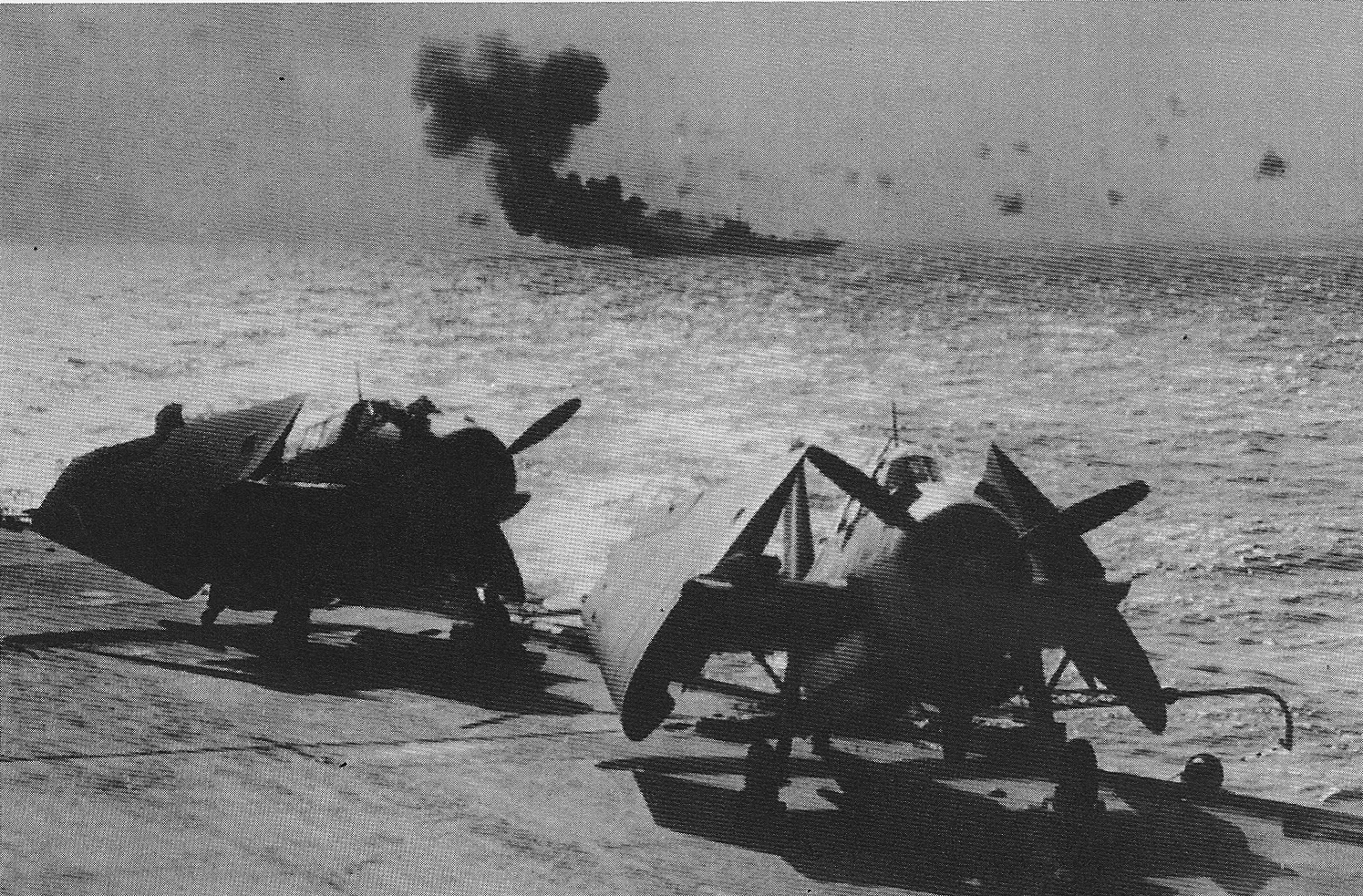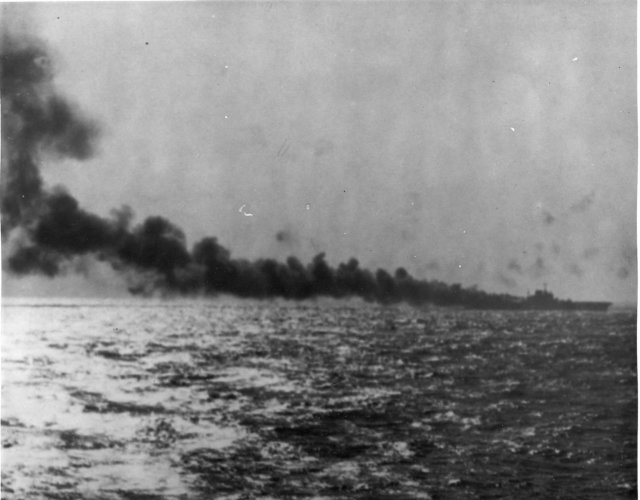KAMIKAZE ATTACK: MAY 9
HMS Formidable would again face-off with a kamikaze when the fourth aircraft in a raid on Task Force 57 managed to slip past the Seafire “JACK” patrol and charge through the fleet’s anti-aircraft umbrella.
The damage from the first kamikaze strike, on May 4, was all but repaired. There was just the disconcerting 'bump' in the flight deck armour amidships pilots now had to get used to.
The second kamikaze - identified as either a Jill or a Zeke with drop tanks under each wing - appeared at first to be attempting an attack run on Formidable from directly astern.
The pilot – either through indecision or engaging in some creative evasive manoeuvres – suddenly changed course. It swung towards Indomitable. Then, at the last moment, it turned again and dove towards Formidable.
Flying flat and straight, the aircraft was hit repeatedly by gunfire from both carriers.
This time Formidable had been given more warning and new “anti-hawk” procedures were in place.
The first strike had killed several men on the flight deck who didn’t hear the alarm because of the sound of the engines of aircraft taxiing. As a result, it was decided that someone on the bridge would now wave a red flag to warn of a kamikaze approaching in addition to the usual sirens.
This new procedure saved Flight Commander Keith Quilter’s life.
“I was strapped into my aircraft with the engine running. Suddenly I saw someone frantically waving a red flag in front of me. I switched the engine off, unstrapped myself as quick as I could and me and three other pilots leapt out of our fighters and jumped down two of three decks before it hit the ship. The ship lurched as the kamikaze hit us. My aircraft was completely destroyed.”
The flight deck crew was sheltering beneath the armoured deck and only the gunners remained exposed.
HMS FORMIDABLE vanishes behind an eruption of fire and smoke after a kamikaze and its 500lb bomb struck the armoured flight deck amidships.
Impact
At 1707, the kamikaze slammed into the aft deck-park.
The bomb detonated on the midline of the armoured flight deck, a few feet aft of the previous impact point.
It was assessed to be a 500lb weapon or similar-sized modified shell. It appeared to only partially detonate in the impact.
Flames, smoke and shockwaves once again lashed HMS Formidable. A wheel sent flying by the blast decapitated one man, while flash and debris wounded four more.
The unfortunate casualty was the Petty Officer in charge of S3 pompom. He had remained standing after ensuring that everybody else was under cover. He was hit by a Corsair’s wheel.
HMS Formidable would claim to have shot down one of the kamikazes.
Admiral Vian would comment:
With the suicide planes screaming straight down at them and seemingly to burst amongst them, the guns’ crews remained serving their guns undismayed, but for which the fact more kamikazes would have scored direct hits. On board Indomitable their coolness filled me with admiration. Reports from the other ships of the squadron told the same tale.
To the surrounding ships, the blast seemed even more intense than that of May 4. The explosion was huge, sending a billowing fireball high into the sky. But as the smoke and flames dispersed, Formidable was seen to be maintaining course and speed.
WITNESS ACCOUNT, MAY 9
From P. D. Evans, HMS FormidableMy action station was on S3 pom pom where Petty Officer George Hinkins was killed during the second kamikaze attack on Formidable. My job with the gun’s crew was to pull open when ordered, two ejector levers which controlled two magazines which I had to keep fed with ammunition.
On this occasion, George shouted to open ejector levers and then to take cover which I did. I went behind the funnel of the ship which was adjacent to the gun, where I remained with others until after the kamikaze hit. During this time S3 pom pom had kept firing.
After the explosion I very cautiously went back to the gun with the Leading Seaman, who was second-in-command of the gun. There were bits of fabric burning on top of a ready use ammunition locker which we attended to. There was also an eerie feeling which is difficult to describe. I’m sure we both suspected that George was dead or badly wounded. It took me a couple of seconds to pluck up enough courage to climb onto the gun and look towards the position where George was.
I can clearly recall that a small part of the knee of his overall was smouldering but there did not appear to be any injury. At this time Buffer appeared and shouted for a sick berth attendant who was quickly on the scene. He examined George and conveyed to us that he was dead. I can assure you that this is a true account—and I can also assure you that George Hinkins was the only one on the gun when the kamikaze hit Formidable.
A slight depression and blistered armoured plate was the sum total of damage done to HMS FORMIDABLE by the May 9th kamikaze strike. Top left, a sweeper is manning his broom.
Deck damage
Fire immediatley took hold among three aircraft ranged on the deck.
Six Corsairs and an Avenger on the deck were destroyed. Two further Corsairs were damaged. The burning wreckage produced a column of smoke and the freshly repainted island superstructure was once again blackened by fire.
The bomb had depressed the flight deck armour by up to 4.5in around the impact point at Frame 94, but had not penetrated or breached the heavy plate.
However, the explosion had blasted a rivet down and out of the flight deck and burning fuel spilled into the hangar below. With the salt-water sprinkler system engaged in “C” Hangar by the assigned damage control team, the fire was quickly doused. But the corrosive water would damage another three Avengers and eight Corsairs.
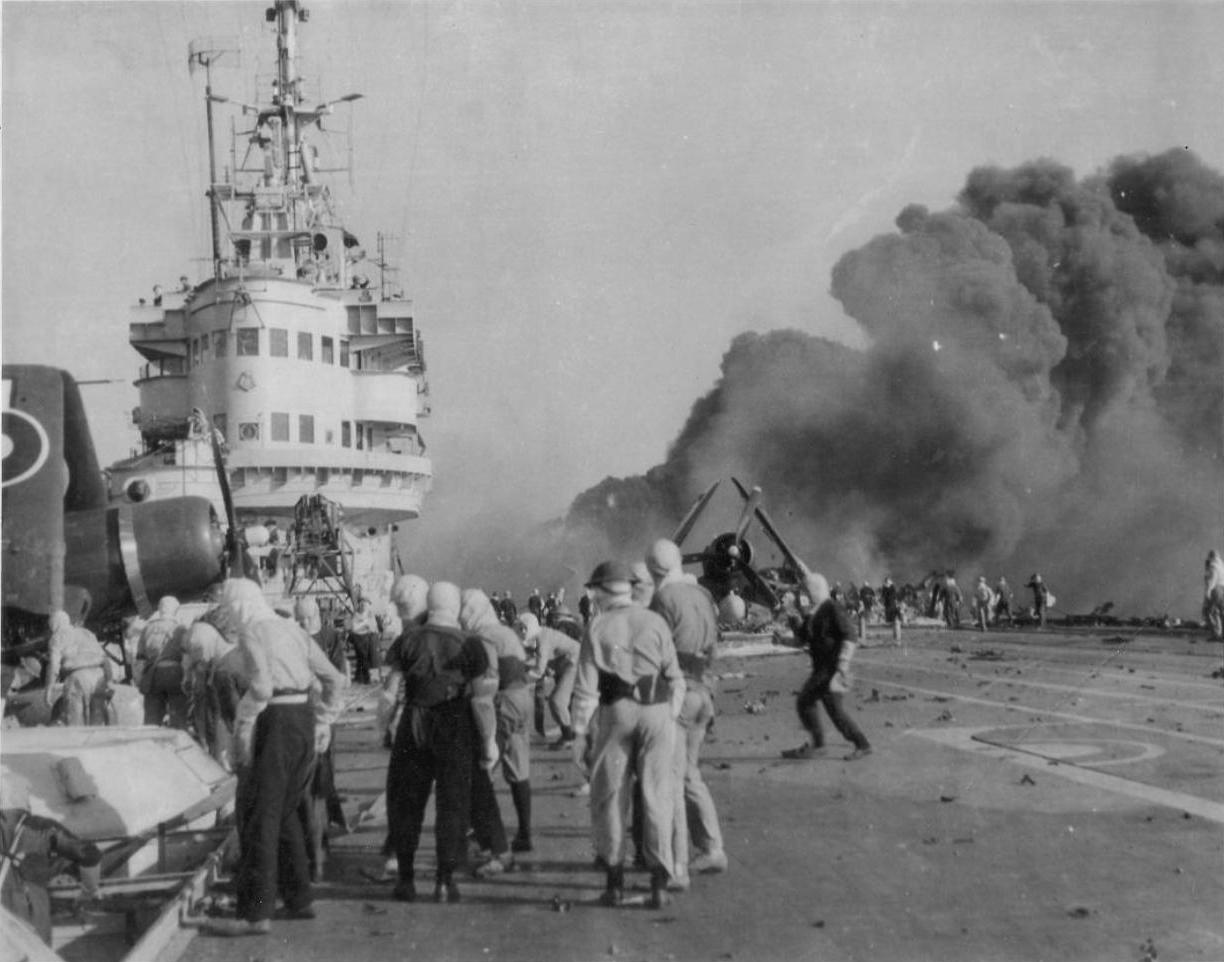
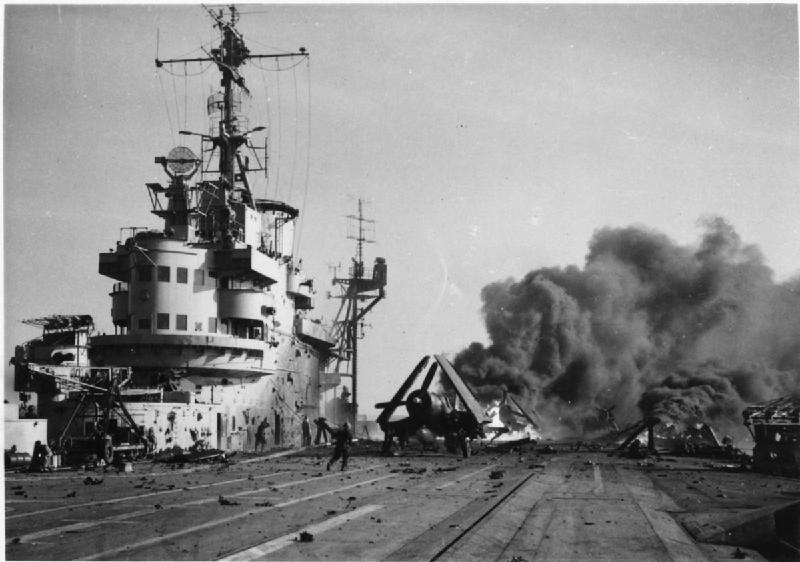
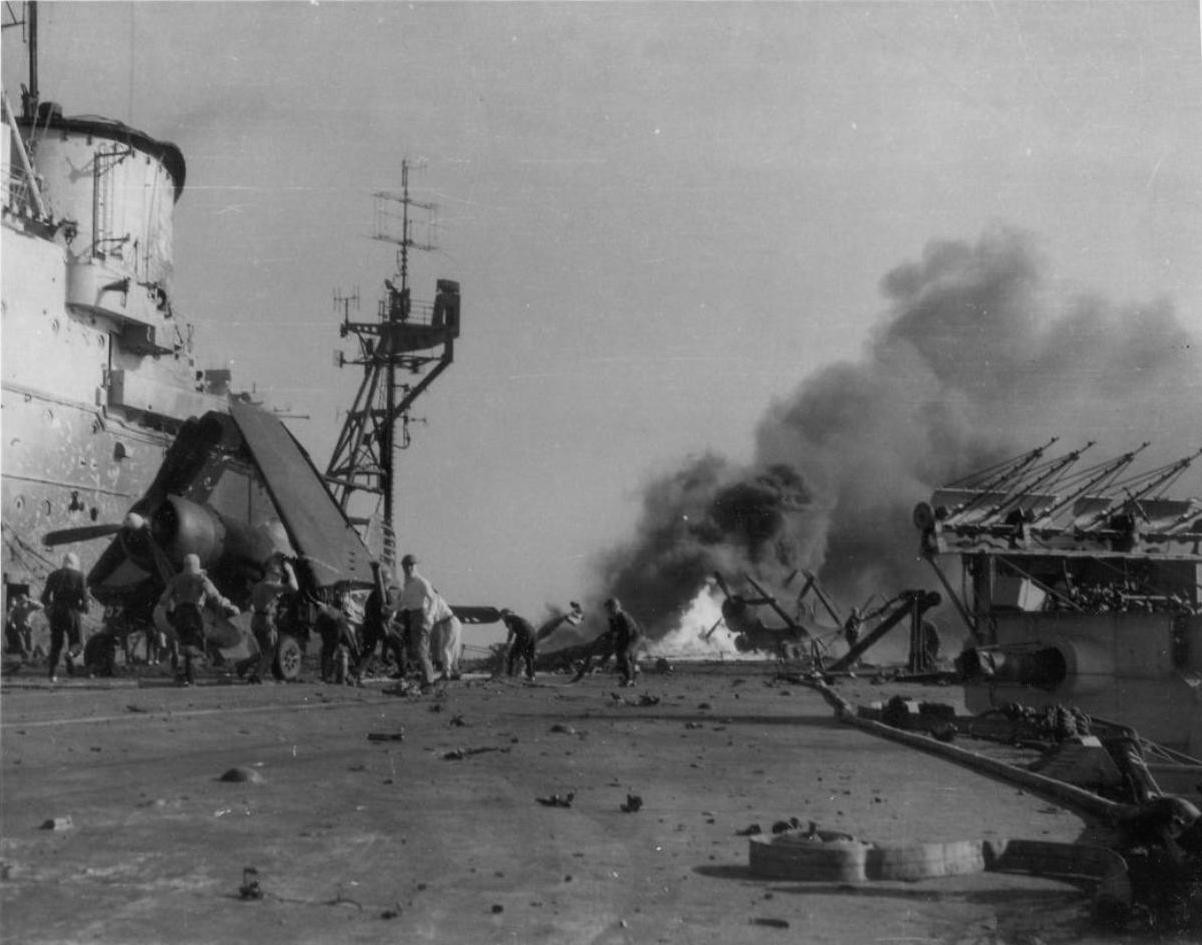
Fighting the fires
Formidable’s captain quickly ordered the ship slowed to 15 knots. This was to reduce the airflow fanning the flames on deck.
Formidable’s crew had learnt from the previous kamikaze strike. All the fires were put out within 15 minutes. Flight deck operations were resumed some 35 minutes later.
WITNESS ACCOUNT, MAY 9 AND MAY 18
From P.O. George Bullamore, HMS Formidable 308The aircraft were returning from the strike, landing on, then ‘spotted’ for refuelling and rearming. Everyone was getting on with the job when we realized Anti Hawk Stations had been sounded and the gun’s crews already in action. I sprinted down the flight deck, down the after access ladder without touching the treads following the one in front, landing at the bottom and dived right for cover when this almighty crash and judder rocked the ship.
Then back up on deck again with the gang. L/AM Dackombe responsible for the rope hooked on to a piece of burning wreckage and pulled it away from what looked like an overload tank. At the same time being swamped by one lot spraying foam and another lot with water. And the ammunition cooking off. In the middle of this P.O. Harvey who was in charge of a fire party came rushing up to me and said the spare Avenger was on fire in the Hangar. A rivet from the flight deck armour had been blown down and smashed into the turret of the aircraft we had worked on the previous night. I left L/AM Dackombe in charge and made my way to the port side after access to the hangar, as the armoured doors were across and the access doors dogged on.
There was the ‘Stoker Damage Control’ by the door. I had to convince him quickly to let me in as the aircraft still had the bombs on. The hangar sprayer was working but the fire curtain was buckled and would not operate (from the impact of the kamikaze). There was smoke but I couldn’t see any fire.
As quickly as I could, I removed the detonators from the 4 x 500lb bombs thus making them fairly safe. Also the arming pistols. Taking the detonators and the phosphorous bomb from the pilot’s cockpit (this was to be activated by the pilot should he land in enemy territory). With this lot he managed to get damage control to let me out of the hangar and promptly rushed to the weather deck and tossed them over the side. Seemed a good idea.
By this time Mr. Branch W.O. arrived (I/C ships and H.Q. Armoury) to see what the situation was as he was concerned about a number of semi armour piercing bombs which were also stowed in hangar ready for the next strike. These also had detonators in ready. I got one of my armourers, a lad named Peers, to bring me a detonator extractor from our deck-head office and any spare tins of det. holders. (These bombs were prepared in readiness to be loaded on the Corsairs.) Anyway removed all the detonators and safely stowed, as they had all to be accounted for at some time later. I then collected the other four armourers and we removed the 500 lbs from the Avenger and secured them to the bulkhead in the hangar.
I wonder if the captain ever knew how close it was should I have slipped up and punctured a detonator while removing it from the bombs?
During one forenoon we were closed up with the fleet train having transferred supplies and ammunition. We were all engaged in daily tasks required to keep aircraft serviceable, when a clatter of machine-gun fire ripped through the wing of an Avenger injuring one of the lads in the leg. One other air mechanic on a Corsair had unfortunately pressed the firing button. This caused a fire which eventually became a disaster as the hanger became filled with smoke and the fire curtains would not operate because of previous damage from the first kamikaze. Again I was involved because of the bombs stored in the hangar which were to be taken up to the flight deck later for the strike aircraft. Earlier in the service I had been at Rosyth Dockyard and completed the damage control fire fighting course in the mock-up of ships compartments. So this training stood me in very good stead giving me the confidence to get to grips with the situation. Anyway much later, covered in grime, soot, oil, etc., wet through I eventually made my way back to our P.O.’s mess to find that they had a mess muster and I was still missing, which fortunately was not true. This damage really had made a mess of things almost wiping out most of the aircraft.
Return to action
At 1755, Captain Ruck-Keene once signalled that his carrier was ready to land her aircraft.
The problem was, he had very few aircraft left to operate. There was only 11 Corsairs and four Avengers in flyable condition out of her original complement of 54.
Formidable had been in the war zone for only a matter of weeks. Now, she looked like a tired old veteran.
This extract from 1841’s Squadron Diary paints the picture:
We now have a flight deck with a gentle undulating motion going for’d from abaft S3 pompom, not to mention a square patch wh ich breaks this movement and causes ‘premature flight’, a number 2 barrier which is ‘getting tired’ to quote the Captain’s telegram and many foamites which need replenishing. Our new towing cars have had their time and so have the special elevators. Only Jumbo remains! They may yet find shrapnel in his insides. The island needs painting again though there is little fresh damage. The radar is beginning to look like a set of rusty pipes!
WITNESS ACCOUNT: “A FORMIDABLE COMMISSION”
Alarm-to-arms was sounded, the bugle which was our air-raid siren and which set everyone running to his appointed place, knocking everyone else over as he ran. Trying to remember to put on my anti-flash gear before my tin hat, I watched the gunfire to port heralding the approach of two hostile aircraft which had evaded our combat air patrol. The next call, anti-hawk stations, was sounded off; this told everyone who could to take cover and the squadron gangs – squadron maintenance personnel detailed – to close up just below the flight deck ready to augment the fire parties.
Gunfire broke out in the fleet. Aircraft were seen diving towards Victorious and our 4.5in guns joined in the attack upon them. Two Kamikazes, both on fire, were seen to crash to crash on Victorious. A few minutes later there was gunfire to port and I could make out two aircraft, fairly low, flying so as to pass astern. The blue sky was filled with little black puffs which marked their passage towards us, and tracer criss-crossed among them as each ship came within range. Our port-after battery began firing and then most of the close-range guns joined in – although the range was really too great for the latter. Both aircraft passed astern about a mile and a half away. One of them began a shallow dive towards Howe, and was shot down alongside her. This plane was accurately engaged by our guns as well as those of Howe. The other, to our intense interest, banked to its left and headed straight for Formidable from fine on the starboard quarter where, as before, not many of our close-range weapons could bear.
The air was shuddering with gunfire and again I thought it could not get through. As it dived closer I could see that it was a largish machine and liable to make a big mess. I watched it long enough to see bits fly off its starboard wing and then lay down flat in the “walk” behind my guns; these being on the disengaged side could do nothing. We and the eight-barrelled pop-pom immediately aft of us were opposite the point of the deck at which Kamikazes usually aim and it was a long five seconds to wait.
Then came the crash and a wall of flame curled down from the deck above and seemed to encircle the pom-pom mounting. I got up to run as it looked like coming my way, but a cloud of smoke took its place. The sea for hundreds of yards round became a mass of splashes as pieces of wreckage hit the water.
With the thought that the pom-pom crew must all have been hurt, I climbed up to the flight deck and found things much as they had been five days before. Burning wreckage that had just before been aircraft, a re-blackened island (it had just been painted since the last episode), smouldering debris everywhere and clouds and clouds of thick black smoke rolling aft and upwards. There was more fire on deck this time for there were more aircraft to provide its fuel; but we were soon to discover that the deck had not been penetrated. We lost eight out of a deck-park of some eleven Corsairs.
Because our recent experience had enabled us to improve parts of the organization the fire-fighting went fairly well. Fires were fought and wreckage and unburnt aircraft hauled clear. It did not help us that the concussion had burst all their tyres. The leading aircraft was burning furiously when all at once its ammunition began to go off with a regular popping sound, accompanied by streaks of light as the tracer bullets departed. The “CO2” machine was brought to bear on this without much effect and when the ammunition had exhausted itself the fire was put out with foam.
Once when busy in a corner with a hand extinguisher I looked up to find the whole flight-deck deserted. The take-cover signal had gone again as another attack was in progress, and I had not heard it. I reached the boat deck in record time. This signal, consisting of a red flag on the bridge and a broadcast klaxon horns, had been introduced since the first attack and today proved its worth; for our casualties were only one killed and four wounded.
Back on the flight deck I was surprised to find that the pom-pom crew had escaped unhurt, which was a good advertisement for their anti-flash gear. The fatal casualty was the petty officer gunlayer of the pom-pom mounting on flight-deck level who had continued gallantly to fire his gun until the suicide plane struck a few feet away from him. His head was taken off by an aircraft wheel.
It was found that this Kamikaze had hit the ship about 10 yards farther aft than his predecessor (who happened to strike the intersection of four armour plates) and had not penetrated the deck.
Ben Hedges said he thought an American carrier of similar size with its wooden decks might well have been sunk by this attack. Another point of interest was that this second attack finally proved that our 20mm Oerlikon shells were not heavy enough effectively to stop a suicide bomber. Both our attackers were repeatedly hit as they came in.
Corsairs in British Pacific Fleet markings sit inside HMS FORMIDABLE'S hangar.
HANGAR FIRE
On Friday May 18, HMS Formidable had just completed refueling the destroyers HMS Norman, Tenacioius and Ursa.
As the carrier turned back on to an aircraft operating course, armourers were routinely loading ammunition into the guns of the aircraft.
At 11am, a Corsair’s guns were accidentally discharged. The 50cal rounds slammed into an Avenger which erupted into flames. The hangar sprayers for that sector were immediately activated, but the fire was too intense. Burning petrol quickly spread among the stowed aircraft.
Formidable’s fire curtains - installed to prevent just such a scenario - were inoperable due to shockdamage sustained in the two prior kamikaze attacks.
When the fire was extinguished 55 minutes later, it was found 30 Corsairs and Avengers had been destroyed (about five) or severely damaged (most were graded as 'flying duds' due to water, foam and smoke exposure). Only 15 of the aircraft aboard Formidable the time remained operational.
As many spare aircraft as possible were transferred from the escort carriers, but Formidable remained considerably under-strength
Admiral Rawlings kept the blackened carrier on station for a few more days to provide a much needed flight deck. But it soon became clear all four carriers would soon be required for the coming push against the Japanese home islands themselves.
So, at 1906 on May 22, Formidable was detached from the fleet and sent towards Sydney a few days earlier than the rest of Task Force 57.
HANGAR FIRE, MAY 18
From Sto. PO Arthur Camfield DSM,
HMS Formidable 306I was sent to the Formidable to take charge of the firefighting in the hangar. I had been through a special course of firefighting. At that time I was Stoker P.O. I had to report to Mr. Charlcraft, a Sub-Lieutenant, and he just said, ‘Well, it’s all yours.’
I had a fire party of 12 and we used to keep the equipment in good working order and four were always on duty. On this day in May we were going back to Sydney for repairs, stand easy had just finished that morning I was walking through ‘B’ hangar when I heard what sounded like shooting and then a flash and a shout of ‘Fire!’
I turned round and there in ‘B’ hangar was a plane on fire. I grabbed the first fire extinguisher and started to fight the plane on fire. Five of my firefighters came and helped and we almost got the fire out but someone opened the big sprinkler wheel in the hangar access and sent tons of water down on us. We had to evacuate the hangar wet through, but the fire was out.
Our lungs were full of smoke and we went out on the weather deck to get some fresh air but were ordered back into the hangar by the upper deck Commander to investigate what had happened. We found that a mechanic had been renewing batteries in a fighter plane and had set off the guns and the bullets had pierced the petrol tank of an Avenger and set it alight.
We returned to Sydney where the Duke of Gloucester came on board and the fire parties were introduced to him. I remember what he said: ‘You started the fire yourselves and you put it out yourselves. Good.’
Aftermath
Once the battle-scarred HMS Formidable returned to Sydney on May 31, she was immediately taken into the new Captain Cook Dry Dock on Garden Island. She would stay there almost a full month.
Once the dockyard workers were aboard, repairs began in earnest. The temporary steel plates and concrete used to patch the hole in the flight deck were ripped out and the damaged plates removed for assessment.
It was found the first kamikaze had struck a point where three 14 ton armoured plates joined. They were removed and two were straightened and put back into position. The third had to be replaced by a double-layer of 1.5in plate. A deck girder also had to be replaced.
The blackened island received considerable attention to ensure all the splinter holes were properly patched. Several distorted steel plates were removed and fittings and equipment in the wrecked offices replace. But most effort went into replacing the jury-rigged electrical and radar wiring. This was soon replaced with miles of professionally fitted kit.
A new requirement was the incorporation of an Admiral’s staff cabin and a radar workshop. This was because Indomitable was expected to be out of action for some time with her shaft problems, and Admiral Vian was planning to move to HMS Formidable.
Space for the Admiral’s personal bathroom was found in a disused lift shaft. The lift had been put out of action in the May 4 attack, and the only replacement parts were thousands of miles away in Britain.
Boilers, machinery and electrical systems – particularly in the hangar – were extensively reworked and repaired. The bent and buckled crash barriers on deck close to the island were also overhauled.
HMS Formidable's aft flight deck as seen from HMS Euryalus during an underway replenishment operation during the British Pacific Fleet's deployment off Sakishima Gunto.
PERFORMANCE
Between June 1944 and December 1945, HMS Formidable steamed 112,823.5 miles in 6118 hours, 11 minutes. During that same time she conducted 4234 deck landings:
Avenger - 1087
Barracuda - 464
Corsair - 2457
Hellcat - 157 (some at night)
Wildcat - 66
Walrus - 1
Seafire - 1
Firefly - 1
